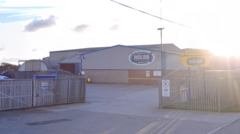What Caused the Massive Blaze at the Recycling Center?

Understanding the Impact of Fires at Recycling Centers: A Case Study from South Wales
Fires at recycling centers can pose significant challenges not only for the immediate environment but also for the communities surrounding them. Recently, a large fire erupted at Nolan Recycling in Stormy Down, near Pyle, Bridgend, prompting emergency services to spring into action. With over 40 firefighters battling the blaze, which was reported at approximately 18:19 BST, the incident underscores the potential hazards associated with waste management facilities. Residents were advised to keep windows and doors closed to avoid smoke inhalation, highlighting the direct impact of such events on local populations. In this article, we will explore the causes, consequences, and preventive measures related to fires at recycling centers, using the South Wales incident as a focal point.
The Causes of Fires at Recycling Centers
Understanding the causes of fires at recycling facilities is critical for developing effective prevention strategies. Several factors can contribute to such incidents, including:
1. Flammable Materials
Recycling centers handle a variety of materials, many of which are flammable. Common items include:
- Plastic bottles and containers
- Papers and cardboard
- Electrical appliances
- Hazardous waste, such as batteries
Improper storage or sorting of these materials can lead to spontaneous combustion or ignition from external sources.
2. Mechanical Failures
Heavy machinery and equipment are essential for processing recyclable materials. Mechanical failures, such as overheating of machinery or malfunctioning equipment, can trigger fires. Regular maintenance and inspections are crucial in minimizing these risks.
3. Human Error
Human error is often a contributing factor in fire incidents. Negligence, improper handling of materials, or failure to adhere to safety protocols can result in dangerous situations. Training and ongoing education for employees are vital to mitigate these risks.
4. Environmental Factors
Weather conditions can also play a role in fire incidents. High temperatures, dry conditions, or strong winds can exacerbate a fire's spread, making it more difficult to contain. Community awareness of weather-related risks is essential for preparedness.
The Immediate Consequences of Fires
The immediate consequences of a fire at a recycling center can be severe, affecting both the facility and the surrounding community. Some of the key impacts include:
1. Health Risks
The release of smoke and toxic fumes poses significant health risks to nearby residents. In the case of the Nolan Recycling fire, residents were advised to keep their windows and doors closed to minimize exposure to harmful pollutants. Symptoms of smoke inhalation can range from mild irritation to severe respiratory issues.
2. Environmental Damage
Fires at recycling centers can lead to environmental contamination. Burning materials release hazardous substances into the air, soil, and water. The long-term effects on local ecosystems can be devastating, leading to loss of biodiversity and habitat degradation.
3. Economic Impact
The economic ramifications can be substantial. Facilities may face significant repair costs, and local businesses can suffer from disruptions. Furthermore, the negative publicity surrounding a fire can impact community trust in waste management services.
The Response to Fires: Case Study of Nolan Recycling
The response to the fire at Nolan Recycling involved over 40 firefighters, illustrating the scale of such incidents. The South Wales Fire and Rescue Service deployed six fire engines to the scene, emphasizing the need for a robust emergency response system. The fire was reported to have been contained, but the ongoing efforts to extinguish it highlight the complexities involved in managing large-scale blazes.
1. Emergency Protocols
Emergency protocols are crucial in managing fire incidents effectively. This includes:
- Rapid response teams trained to handle hazardous materials
- Clear communication channels between emergency services and local authorities
- Public advisories to ensure community safety
2. Community Involvement
Community involvement plays a significant role in the response to fire incidents. Local residents can aid emergency services by:
- Reporting suspicious activities or fires promptly
- Staying informed through official channels
- Participating in community safety drills
Long-Term Strategies for Prevention
While immediate responses are essential in managing fire incidents, long-term strategies can significantly reduce the risk of future fires at recycling centers. These strategies include:
1. Improved Training Programs
Training staff on fire safety and emergency procedures is vital. Regular drills and education on handling flammable materials can help mitigate risks.
2. Enhanced Fire Safety Equipment
Investing in fire safety equipment, such as sprinklers, fire extinguishers, and alarms, can help contain fires before they escalate. Facilities should be equipped with the latest technology to detect fires early.
3. Regular Inspections and Maintenance
Conducting regular inspections of machinery and equipment can prevent mechanical failures that lead to fires. Maintenance schedules should be strictly adhered to, ensuring that all systems are functioning optimally.
4. Community Awareness Campaigns
Raising awareness among community members about the risks associated with recycling centers and fire safety can empower residents to take proactive measures. Information sessions and materials can educate the public on how to respond in case of a fire.
Conclusion
Fires at recycling centers present significant challenges that can affect health, the environment, and the economy. The recent incident at Nolan Recycling in South Wales serves as a reminder of the importance of fire safety and preparedness. By understanding the causes and consequences of such fires, communities can work together with emergency services to develop effective strategies for prevention and response. As we reflect on these events, it is vital to consider how we can enhance safety protocols and community awareness to ensure a safer environment for everyone.
FAQs
What should residents do if there is a fire at a nearby recycling center?
Residents should follow local advisories, keep windows and doors closed, and avoid outdoor activities until the situation is resolved. It’s also essential to stay informed through official channels.
How can recycling centers prevent fires?
Preventive measures include regular training for staff, maintaining equipment, investing in fire safety technology, and educating the community about fire risks.
What are the health risks associated with smoke from recycling center fires?
Smoke from fires can cause respiratory issues, eye irritation, and other health problems. Vulnerable populations, such as children and those with pre-existing health conditions, are particularly at risk.
As we navigate the complexities of fire safety at recycling centers, how can communities better prepare themselves for potential hazards? #FireSafety #CommunityAwareness #RecyclingResponsibility
Published: 2025-06-18 21:43:07 | Category: wales



